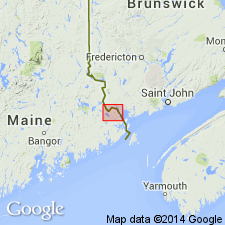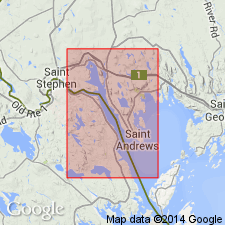
- Usage in publication:
-
- Red Beach Granite
- Modifications:
-
- Overview
- Dominant lithology:
-
- Granite
- AAPG geologic province:
-
- New England province
Summary:
Red Beach Granite consists chiefly of hornblende granite and biotite granite. Cuts Eastport Formation; underlies Perry Formation. Age is Early Devonian(?).
Source: GNU records (USGS DDS-6; Reston GNULEX).

- Usage in publication:
-
- Red Beach Granite
- Modifications:
-
- Overview
- Areal extent
- AAPG geologic province:
-
- New England province
Summary:
Red Beach Granite underlies 40 percent of area defined as quadrilateral with corners at Coleback Lake, Nashs Lake, Devils Head, and Mills Cove on the St. Croix River, eastern ME. Unit is composite of six distinct intrusions. Medium and coarse-grained biotite granite members are tentatively correlated with the Charlotte Granite. Fine-grained biotite granite and hornblende granophyre members are older than the Charlotte. Other members not discussed. Intrudes Eastport Formation and unconformably underlies Perry Formation. Age is Early Devonian.
Source: GNU records (USGS DDS-6; Reston GNULEX).
For more information, please contact Nancy Stamm, Geologic Names Committee Secretary.
Asterisk (*) indicates published by U.S. Geological Survey authors.
"No current usage" (†) implies that a name has been abandoned or has fallen into disuse. Former usage and, if known, replacement name given in parentheses ( ).
Slash (/) indicates name conflicts with nomenclatural guidelines (CSN, 1933; ACSN, 1961, 1970; NACSN, 1983, 2005, 2021). May be explained within brackets ([ ]).

